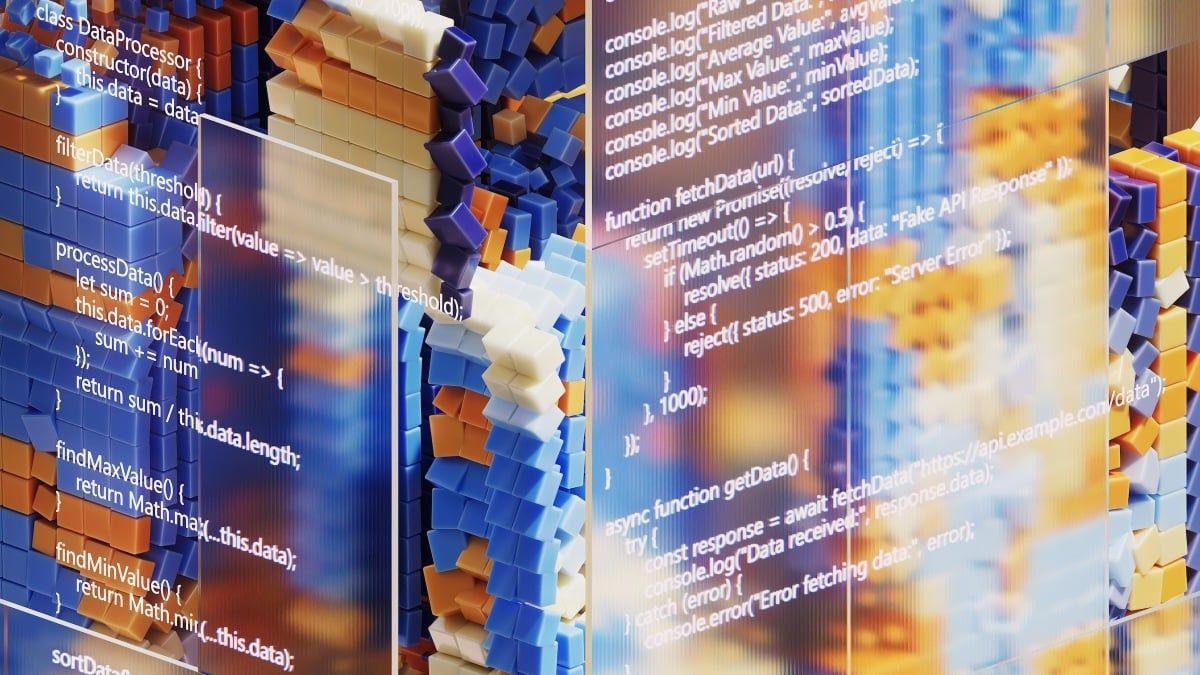The Rise of 'Vibe Coding': AI-Powered App Development for Non-Programmers
2 Sources
2 Sources
[1]
I make websites and apps from simple prompts using AI -- and it's really easy to do
Non-programmers can now use AI to create their own apps on demand You may, in your travels around the AI universe, have come across the term 'vibe coding' and wondered what it was. The term was originally coined by OpenAI co-founder Andrej Karpathy in a February 2025 tweet. His quote came at a time when the quality of AI models had progressed far enough that they were increasingly being used to help programmers write serious code. In his mind this was a watershed moment. "There's a new kind of coding I call "vibe coding", where you fully give in to the vibes...and forget that the code even exists....It's not really coding - I just see stuff, say stuff, run stuff, and copy paste stuff, and it mostly works." Karpathy was not overly enthusiastic about the concept, saying it was 'not too bad for throwaway weekend projects', but his words kicked off a huge discussion in the programming world, which rages even now. On one side are the die-hard, dedicated expert programmers who refuse to believe that AI can ever produce safe, trustworthy code products without human intervention. On the other hand are 'brash' non-expert coders with an idea, who suddenly have an outlet for their creativity that never existed before. It's an argument that's destined to run and run. Vibe coding involves using an AI model to write computer code from scratch to create real-world products and applications. You get the model to create this code by typing your request into a chat box in plain English, as you would with any conventional AI interaction. For example, typing 'create me a simple to-do list app' will, in moments, result in the AI generating what you need. It may not be perfect at first, but to fix and refine, you just continue chatting with the AI to tell it what you need. It's shockingly simple at this level. Of course, professional programmers can push the genre to its extremes. As someone who has personally created over 15 modest but useful AI-coded products over the past six months, I can 100% attest to the fact that vibe coding is a real thing, despite what disbelievers may say. Just last week, in a mere three hours, I created a brand new WordPress plug-in to provide a simple event form for a non-profit I'm involved with. And I'm absolutely no kind of programmer at all. The amazing thing is not that vibe coding works per se, but how well it works. Almost anyone can produce useful apps in a matter of hours without touching a line of code. As long as they understand the constraints and limitations, and avoid trying to be too ambitious (unless they have the necessary skills). Vibe coding is great for small business owners or anyone who wants to create modest little tools they can use to improve their productivity, without having to call on expensive technical expertise. It's also increasingly being used by people who either want to learn about programming or hope to be coding freelancers. The common theme is that they have some technical interest and they're not scared of getting their hands dirty. The first thing to know is that while vibe coding sounds easy, there is some basic knowledge that's required before you start. First, you'll need to understand how files, folders, and computer operating systems work, at least to a basic degree. You'll also need to understand the basics of AI prompting, in effect how to structure your requests so the AI responds the way you want it to. To get started, you need to decide whether you want to do your development in the cloud or on your computer, in which case you'll need a machine with enough processing power and storage space to handle the programming environment the apps need. The key rule of thumb with vibe coding is not to be too ambitious, especially at first. Start with extremely simple apps like to-do lists and that kind of thing, unless you are a proficient coder. While the AI does 99% of the heavy lifting, keeping things simple means it has a better chance of delivering results without errors. Once you're ready, pick your tool (see below) and start thinking of an idea. Make your instructions to the AI clear and simple, and see what the model delivers. The great thing is it's quite cheap to experiment, as long as you don't go crazy. The biggest challenge most newcomers face is how to direct the AI to fix any problems, but the best way is to explain the problem and let the model sort it out. Luckily there's a great choice of methods and tools for vibe coding. Here's a list of options. Chatbots It is definitely possible to vibe code using a standard cloud based chatbot, for instance ChatGPT from OpenAI or Claude from Anthropic. The pros are, you simply open an account in your web browser, click the code button and start chatting like you would do if you're asking a search question. The cons are it involves more hands-on with the code. It is, however, trivially easy to get a simple app created literally in seconds. ChatGPT is more austere than Claude, which uses an elegant interface to create apps. Claude also offers a publish button which gives the user a public URL link which anybody can access to use the new app. With ChatGPT, you have to download the code and understand how to implement the environment which will let it run. Much more complicated. Closed coding tools This is where definitions get a little fuzzy. Strictly speaking, everything that is used for programming is a coding tool, but here we're trying to differentiate between tools that give you access to the actual AI model, and products that mostly hide all that stuff and just deliver the final product. There are an awful lot of these closed AI tools available at the moment, maybe over 20 at last count. Top of the tree for ease of use are Bolt.new and Lovable.com. These two manage to combine the ease of use of a chat box, with the power of some great back-end AI tech. The result is a great way to easily create and deploy micro apps. I've created several apps with Bolt and Lovable, and they both work extremely well. Honorable mentions There are three other tools that I've used that offer soup to nuts vibe coding goodness. Readdy.ai, creates great websites, Macaly.com helped me produce a nice-looking time tracker app, and Heybossai.com offers a bunch of extra value in the form of useful tools and services. Note that many of these tools offer some form of limited free trial so you can test things out first. Open coding tools These vibe coding tools let the user select the specific AI model they want to use for the job. My two go-to favourites are voideditor.com and codecompanion.ai. They are both downloadable programs for Windows or Mac, which let you mix and match any of the most powerful AI models on the market to create your application. I particularly like their seamless integration with my local disk storage, which means I can manage my projects with much more fine-grained control.
[2]
We are Entering the Era of Vibe Engineering | AIM
"Compared to other tools, he said that CodeRabbit generates roughly 5 billion daily tokens. This is mainly for reviewing." Code is just a part of the larger software cycle. However, it is the code that creates a lot of friction in the team. Ask most developers, and they'll tell you that code reviews, meant to ensure quality, can sometimes feel like heated debates rather than helpful feedback sessions. Aravind Putrevu, director of developer GTM at CodeRabbit, believes that AI is about to soften the edges of this process. "The way I see it, AI brings impartiality to code reviews," he said. "It doesn't have an ego. It's not there to nitpick or win an argument. It's there to help." Putrevu pointed out that developers are often introverted by nature. Apart from team standups or collaborative debugging, the one place where they're forced into meaningful conversations is during code reviews. "That's where opinions clash, egos get bruised, and things can sometimes get ugly," he said. "You're defending your code while someone else pokes holes in it." AI tools like CodeRabbit are trying to change that dynamic by stepping in as the "first line of defence". They catch the obvious mistakes, enforce style guidelines, and suggest improvements before a human reviewer takes over. "We're not removing the human from the loop," he clarified. "The developer still makes the final call, but AI can take care of the silly stuff." Click here to check out CodeRabbit on VSCode. This new workflow -- dubbed 'vibe checking' -- mirrors the vibe shift in coding. Earlier, developers wrote everything by hand. Now, with tools like GitHub Copilot, Cursor, and Lovable, AI helps generate significant chunks of code. The review process is just catching up. Another big trend Putrevu noted is the rise of "vibe coding" tools -- applications like Lovable or Replit that let non-coders build apps using natural language prompts. On the surface, this seems like a revolution. Guritfaq Singh, co-founder at CodeRabbit, offered a word of caution. "It's like learning to drive but not knowing that petrol is flammable," he said. "You can go fast, but you're missing the fundamentals. You don't understand version control, code maintenance, or why code behaves a certain way." He recounted a recent interaction with a popular educator experimenting with an AI tool. "He didn't know what YAML was. And this person was teaching others how to use these tools!" Singh laughed. It's not his fault, really -- it just shows that we need better guidance and more senior developers mentoring these new users. And that's where CodeRabbit comes in. "It acts like a senior engineer sitting next to you," he says. "It guides you, reviews your pull request, and helps you avoid costly mistakes." Compared to other tools, he said that CodeRabbit generates roughly 5 billion tokens per day. This is mainly for reviewing. There's no doubt AI is generating a lot of code. Cursor reportedly outputs close to a billion lines of code per day. Google recently said over 50% of the code in its repositories is now AI-generated, and YC Startups are generating 90% of their code with AI. Alarm bells went off when Anthropic CEO Dario Amodei predicted that in less than six months, AI would handle 90% of coding. This is similar to what Sridhar Vembu, founder of Zoho, thinks. He recently said that 90% of what programmers write today is 'boilerplate'. But that doesn't mean we need fewer engineers. Quite the opposite. There's a whole new generation of developers coming in -- many from non-traditional backgrounds. The demand is only going to grow. However, there's a catch. Developers who resist learning these tools could be left behind. "It's like going from a hand-pulled rickshaw to an engine-powered one," he said. "You're still the driver, but if you don't learn how to use the machine, you might become obsolete." On social media, there's been chatter about AI tools replacing entire developer teams. Posts have gone viral claiming that a combination of Cursor and Claude could function as a $20/month senior engineer. Putrevu laughed this off, saying that you can't replace the experience and judgment of a seasoned dev with a few prompts. What you can do, though, is give every junior dev a powerful companion. In essence, AI tools today are not the new team -- they're the new teammate. In the past, developers leaned heavily on Stack Overflow and IDEs for instant code assistance -- whether debugging a cryptic error, understanding a library, or finding the right syntax. Putrevu says, "These tools helped individual productivity, not team collaboration." While Stack Overflow served as a lifeline for lone developers, it rarely addressed issues like code consistency, review quality, or contextual feedback within a team setting. Similarly, IDEs were optimised for writing code, not understanding how that code fits into a broader system. This is where tools like CodeRabbit step in, not to replace Stack Overflow or IDEs, but to evolve the development experience into a more collaborative, review-driven process -- embedding intelligent context and feedback right where the developer works. Despite all the promises, there are risks. Too much automation can result in what Putrevu calls "comment overload." He jokes about a meme where a 10-line PR gets 500 comments, while a 200-line PR gets a casual 'LGTM'. That's the danger -- when AI-generated code is accepted blindly. Good code still needs good judgment. That's why the human reviewer isn't going away any time soon. As for the future of vibe reviewing? "It's not about replacing conversations," he says. "It's about making those conversations more meaningful. AI doesn't shut down the vibe. It sets the tone." It remains clear that while the world is vibing to code, there is still no such thing as vibe engineering. While vibe coding can accelerate prototyping, it doesn't replace software engineering. Real engineering involves long-term system design, reliability, scalability, and maintainability -- concerns that current AI-generated code cannot handle. So, despite the hype, there's no "vibe engineering". It's still just engineering, with or without the code typing.
Share
Share
Copy Link
AI-powered 'vibe coding' is revolutionizing app development, allowing non-programmers to create applications using simple prompts. This trend is sparking debates in the tech community about its potential and limitations.
The Emergence of 'Vibe Coding'
The term 'vibe coding' was coined by OpenAI co-founder Andrej Karpathy in February 2025, describing a new approach to coding where developers "fully give in to the vibes" and focus on results rather than the intricacies of code
1
. This concept has since sparked a significant debate in the programming world, dividing opinions between traditional programmers and those embracing AI-assisted coding.Vibe coding involves using AI models to generate computer code from simple prompts, allowing non-experts to create functional applications without extensive programming knowledge. This approach has gained traction, with some individuals reporting the creation of multiple AI-coded products in a short span of time
1
.Tools and Techniques
Several AI-powered tools have emerged to facilitate vibe coding:
- Chatbots: Platforms like ChatGPT and Claude offer code generation capabilities directly through chat interfaces
1
. - Closed coding tools: Products such as Bolt and Lovable provide more streamlined experiences for app creation
1
. - CodeRabbit: This tool acts as an AI-powered code reviewer, generating approximately 5 billion tokens daily for code review purposes
2
.
These tools aim to simplify the coding process, making it accessible to a broader audience. However, experts emphasize the importance of understanding basic concepts such as file systems, operating systems, and AI prompting techniques
1
.Impact on Software Development
The rise of vibe coding is transforming various aspects of software development:
- Code Reviews: AI tools like CodeRabbit are changing the dynamics of code reviews, offering impartial feedback and catching obvious mistakes before human reviewers intervene
2
.

Source: AIM
- Productivity: Major tech companies report significant increases in AI-generated code, with Google stating that over 50% of its repository code is now AI-generated
2
. - Learning Curve: While these tools lower the entry barrier for coding, there are concerns about new users lacking fundamental knowledge of version control, code maintenance, and underlying principles
2
.
Debates and Concerns
The vibe coding trend has sparked debates within the tech community:
- Quality and Safety: Traditional programmers argue that AI-generated code may not be as safe or trustworthy as human-written code
1
. - Job Market Impact: There are discussions about the potential obsolescence of developers who don't adapt to these new tools
2
. - Overreliance on AI: Experts warn against blindly accepting AI-generated code without proper understanding or review
2
.
Related Stories
The Future of Programming
Despite concerns, many see vibe coding as a complementary tool rather than a replacement for human developers. Aravind Putrevu, director of developer GTM at CodeRabbit, suggests that AI tools are becoming new teammates rather than replacing entire teams
2
.
Source: Tom's Guide
The trend is expected to continue growing, with predictions of AI handling up to 90% of coding tasks in the near future
2
. However, the consensus among experts is that human judgment and experience will remain crucial in software development.Conclusion
As vibe coding gains momentum, it's clear that the landscape of software development is evolving. While these AI-powered tools offer exciting possibilities for non-programmers and increased efficiency for experienced developers, they also present new challenges and learning curves. The future of programming likely lies in a balanced approach, combining AI assistance with human expertise and judgment.
References
Summarized by
Navi
Related Stories
Recent Highlights
1
Nvidia locks in $20 billion Groq deal, securing AI chip rival's technology and talent
Business and Economy

2
Geoffrey Hinton warns AI job replacement will accelerate in 2026 as systems gain new capabilities
Technology

3
Deepfakes cross indistinguishable threshold as voice cloning and video realism surge 900%
Technology








